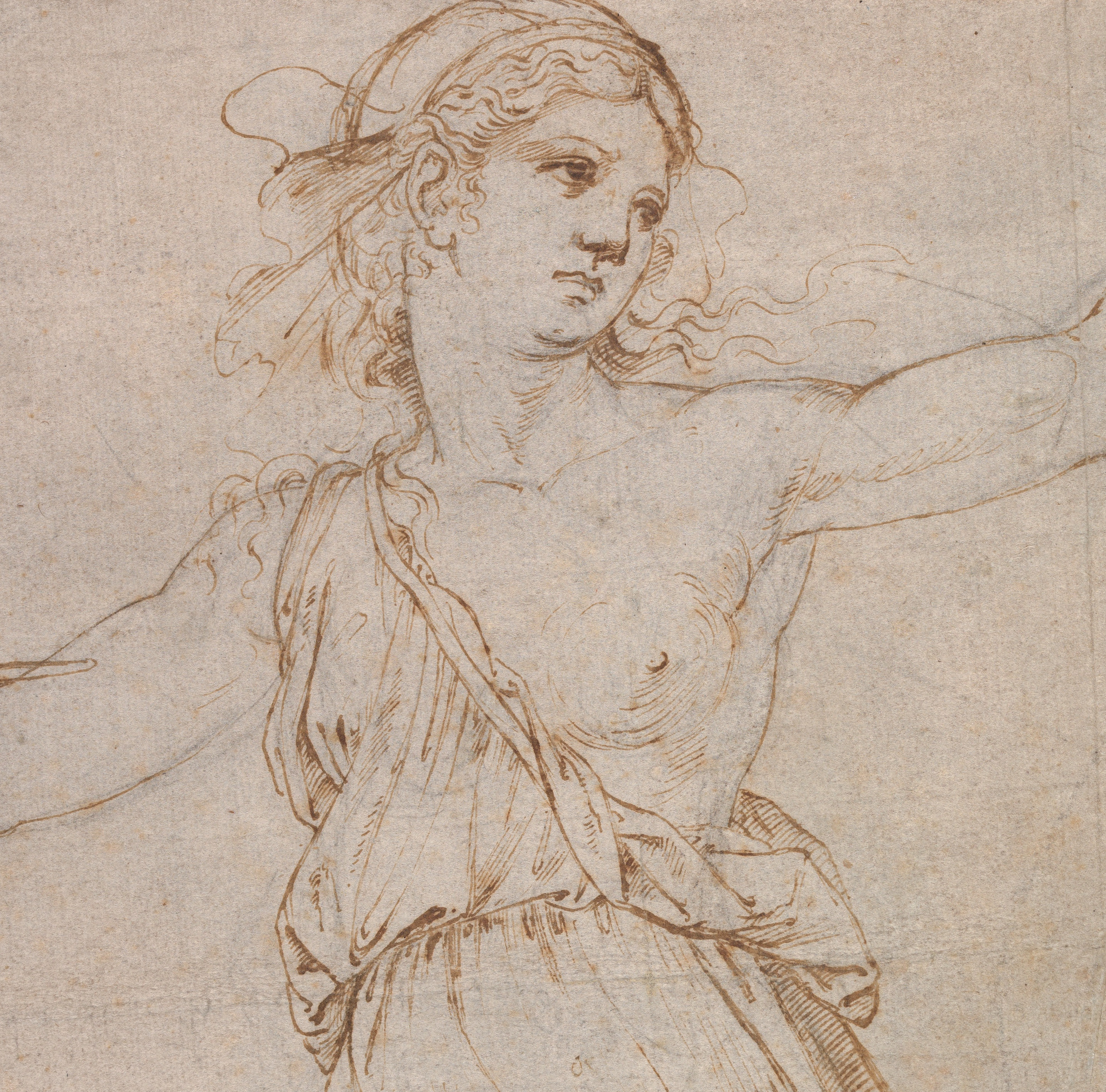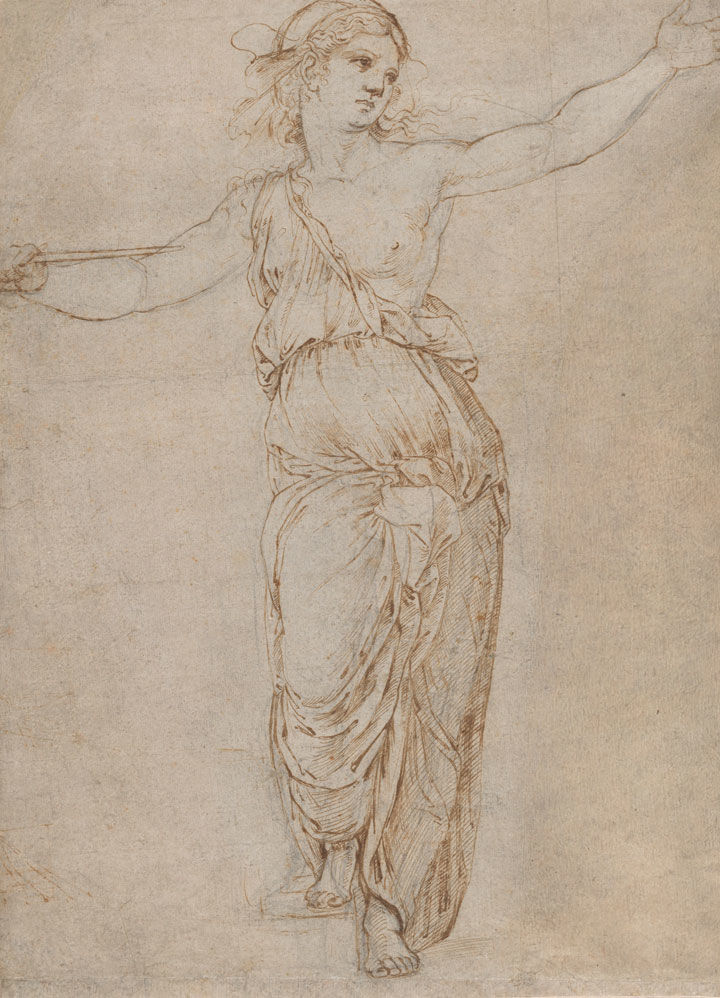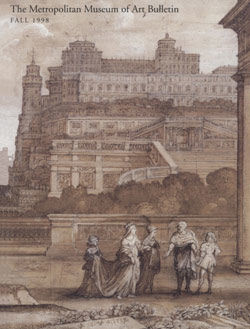Lucretia
Raphael (Raffaello Sanzio or Santi) Italian
Not on view
This monumental drawing, produced by Raphael in his early Roman period, reveals his arresting knowledge of antique Roman sculpture and literary sources. According to Ovid's Fasti and Livy's History of Rome, the noble matron Lucretia committed suicide after being raped by Sextus, son of the tyrant Tarquin the Proud. Her husband, and later Junius Brutus, avenged her honor by leading a revolt that helped institute the republic as a form of government. The artist recast the heroic early Roman legend to focus on the rhetorical gesture of Lucretia as a model of sublime virtue, heightening the drama of her death. Raphael chose to depict the moment when she is about to plunge a dagger into her chest. The sculptural grandeur and monumentality of form evident here speak freshly of Raphael's encounter with Roman antiquity. The proportions of the imposing idealized female figure appear to be those of the canon of antique sculpture, though she is not based directly on any single Roman statue. The style and pen-and-ink technique of this major working drawing by Raphael (the outlines of the design are indented with the stylus for transferring the design) are most closely connected to the famous large-scale preliminary studies for the figures in the Parnassus and the School of Athens, painted in fresco in the Stanza della Segnatura (Vatican Palace).
- CATALOGUE ENTRY
This monumental pen-and-ink study of Lucretia was rediscovered in a collection in Montreal, and was published by Julien Stock in 1984, as by Raphael (Stock 1984); this attribution has been widely endorsed by subsequent scholars with one exception (Pon 2004). The autograph status of this drawing, acquired by the Metropolitan Museum of Art in 1997, is amply confirmed by the numerous pentimenti evident especially in the vigorous, boldly reinforced undersketch in soft black chalk, and the many precise comparisons of style and technique to Raphael’s accepted pen-and-ink drawings for the Stanza della Segnatura frescoes in the Vatican Palace, and in particular those for the Parnassus -- the Standing Man on the recto and the Drapery Study for Horace on the verso (British Museum inv. Pp. 1-74, London), the god Apollo (Musée des Beaux-Arts inv. 452-453, Lille), the muse Melpomene on the recto and Virgil on the verso (Ashmolean Museum P II 541, Oxford), as well as Calliope (Graphische Sammlung Albertina inv. 219, S.R. 262, R. 65, Vienna; for which see Knab, Mitsch and Oberhuber 1983). Typical is the use of emphatic, single contours and carefully descriptive manner of hatching with the pen which in the sheets of greater size can create a somewhat dry overall effect (pen and ink do not naturally glide easily over large surfaces of paper, as a chalk or charcoal stick might). The head of Lucretia, seen in a three-quarter turn and in a slightly foreshortened perspective, as if viewed from below ("sotto in sù") recalls the beautiful design in black chalk for the head of the muse Polyhymnia (Collection of Mrs. Colville, London), an auxiliary cartoon drawn on spolvero dots, also for the Parnassus (Knab, Mitsch and Oberhuber 1983, no. 378). This all suggests that the Metropolitan Museum sheet belongs in the early part of Raphael’s Roman period, perhaps during the first two years of his arrival in the eternal city. He recast here a heroic early Roman legend to focus on the rhetorical gesture of Lucretia as a model of sublime virtue, which heightens the drama of her death.
According to Livy's History of Rome (I:lvi.3 to lx.4) and Ovid's Fasti (II:711-852), the noble matron, Lucretia, had committed suicide after being raped by Sextus, son of the tyrant Tarquin the Proud, and her hushand, and later Junius Brutus, avenged her honor by leading a revolt that would help institute the republic as a form of government. Raphael chose to depict the dramatic moment when Lucretia is about to plunge a dagger into her chest, and his design reveals an arresting command of antique Roman sculpture and literary sources. The pose for the monumental female figure was clearly inspired by a Roman sculpture, for similar statue types can be recognized in the pages of Renaissance modelbooks with copies after the antique, for example, in the Codex Escurialensis by the workshop of Domenico Ghirlandaio (Hülsen, Michaelis and Egger 1905, fol. 48 verso) and in the Rosenbach Sketchbook by Girolamo da Carpi (Canedy 1976, no. R46). But the sculptural grandeur and monumentality of form evident in the Lucretia drawing speak freshly of Raphael’s encounter with Roman antiquity in 1508-10. The proportions of the imposing idealized female figure appear to be those of the canon of antique sculpture, although she may not be exactly based on any single, identifiable Roman statue.
Julien Stock first rightly connected the Metropolitan Museum drawing with the well-known, though sometimes misread passage in the biography of Marcantonio Raimondi in the 1568 edition of Giorgio Vasari’s Vite de' più eccellenti pittori, scultori e architettori. There, Vasari extolled Marcantonio’s virtuosity as a printmaker by comparing him to Albrecht Dürer and Lucas van Leyden, adding: "But to return to Marcantonio, on his arrival in Rome, he engraved in copper a most beautiful sheet by Raphael of Urbino, in which was [represented] a Roman Lucretia killing herself, [done] with such diligence and beautiful manner, that on its being immediately brought to Raphael by some of his friends, he was inclined to have some drawings of his things produced in print, and he took a drawing that was already made of Paris, in which Raphael had designed the chariot of the Sun, the nymphs of the woods, as well as those of fountains and rivers, with vessels, rudders, and other beautiful surrounding fantasies; and thus resolved, they were all engraved by Marcantonio causing all Rome to marvel." (for a full transcription of this passage see Bambach in Ottawa 2009). Vasari’s phrasing leaves no doubt that Raphael’s drawing of Lucretia, and that of Paris for that matter, were produced originally quite independently of their later conception as prints. The passage intimates that Marcantonio’s initial success in engraving the design of such drawings (which were already made) was at the root of his later association with Raphael as engraver of some of the great master’s drawings, and not surprisingly, the extant visual evidence seems to corroborate these points. Two engravings executed by Marcantonio Raimondi (the printmaker in Rome whom Raphael most entrusted with the dissemination of his artistic inventions) resemble the design of Lucretia in the monumental Metropolitan Museum drawing, Dido (Bartsch XIV.153.187) and Lucretia (Bartsch XIV.155.192; Landau and Parshall 1994), although they greatly differ in the details of facial features and landscape setting. The design of both engravings faces in the same direction as the Metropolitan Museum drawing, whereas, it will be remembered, studies explicitly produced for prints are usually drawn in a reverse design orientation, given that the printing process reverses the image. Moreover, the two engravings by Marcantonio inspired by Raphael are in a much smaller scale; in particular, the very closely related print of Lucretia is in a scale of about 1:4 with respect to Raphael’s drawing at the Metropolitan Museum of Art (Stock 1984). The engraving of Lucretia almost exactly follows Raphael’s drawing in the pose and graceful arrangement of the chiton’s folds over the gently twisting curves of the matron’s body, but entirely differs in the design of her head. This detail in Raphael’s drawing is reflected in yet another engraving of Lucretia, by the Bolognese Jacopo Francia, from around 1510-11, when Francia’s work exhibited its closest affinity with the Roman oeuvre of both Raphael and Marcantonio. The engraving of Dido is usually regarded as the earlier of the two designs by Marcantonio (see Shoemaker and Broun 1981, nos. 18, 20), but the story of Dido was similar enough to have allowed Marcantonio to use Raphael’s drawing as the basis for his print (the widow Dido stabbed herself to death rather than marry Iarbus, the barbarian king of Libya, who had threatened her people with war if she rejected him).
Marcantonio’s engraving of Lucretia enjoyed a wide adaptation in other media, including maiolica (See, for example, the dish by the painter "F.R.," from ca. 1525, Urbino, at the Victoria and Albert Museum inv. C.2228-1910, London) and further drawings (including a drawn partial copy in a chiaroscuro medium now in the Codex Resta; See Bambach in Ottawa 2009), while an oil-on-panel painting attributed to the school of Raphael closely reproduces Marcantonio’s design (Courtauld Institute of Art Gallery inv. P1966.GP.336, London), and its underdrawing reveals the firmly traced outlines of a cartoon-derived design. This fact is especially interesting, as the large scale of Raphael’s Metropolitan Museum study of Lucretia is more commensurate with that of a painting (we have seen that it is much larger than Marcantonio’s prints), and the evidence of design-transfer on the sheet – the outlines of the recto being partly indented, and the verso being blackened with chalk or charcoal for a "calco," or "carbon paper" method of transfer (Bambach 1999) -- suggests that it was a highly functional working drawing. The overall condition of the Metropolitan sheet is very good considering its strictly utilitarian purpose, and although the pen-and-ink drawing surface exhibits signs of light abrasion throughout, a considerable part of the energetic black-chalk underdrawing is well preserved. The losses of the original support along the right side and upper left corner of the sheet have been made up, and these replaced areas have been toned to harmonize them with the paper of the drawing.
A recent attempt to demote the attribution of the Metropolitan Museum sheet to the "School of Raphael" seems unpersuasive (the drawing style of Marcantonio Raimondi is sufficiently well-known to rule him out as author; Pon 2004), and much about the archaeological evidence in the drawing was overlooked. Affirming, rather than weakening the attribution to Raphael, and certainly discounting an attribution to Marcantonio, are the facts that the Lucretia drawing is in very large scale (as noted, four times larger than Marcantonio’s Lucretia engraving; Stock 1984) and that it is in the same direction as the print, but displays substantial preliminary, black-chalk underdrawing. This underdrawing is bold -- far from "now-indistinct" -- as it has been described, for the chalk strokes represent numerous reinforcement outlines, attesting to a creative exploratory process. The chalk strokes are now very rubbed, but this is a problem of condition, not of quality of execution. Although the underdrawing can be seen to cover the entire figure, it appears most prominently visible in the draperies, legs, and feet. The use of stylus-indentation and black chalk, or charcoal, rubbed on the verso are quite explainable as part of Raphael’s design process in developing preliminary drafts for compositions, many of these for paintings, and his frescoes exhibit the evidence of "incisioni indirette" (or indirect incisions) from cartoon transfer (Bambach 1999). The reason why Raphael drew the draperies so precisely is that they are most likely based on an antique statue, and Raphael, in his role as archaeologist-draftsman, was interested in accurate recordings of drapery even when he freely altered the rest of his antique models (an example is Raphael’s drawing, Graphische Sammlung Albertina inv. 219, S.R. 262, R. 65, Vienna) after the Sleeping Ariadne and which he reused for the figure of the muse in the Parnassus fresco). This may also explain the reason why Marcantonio bothered to copy this drapery so precisely in both of his prints, the Dido and the Lucretia -- the prints present essentially the same design of drapery, but in mirror orientation with respect to each other. It may have been the antique model which carried the authority. Given that no examples of monumental drawings by Marcantonio exist (and certainly none of the scale of the Metropolitan Lucretia), it seems highly implausible that yet another copyist could copy Marcantonio’s print from a small scale into a large imposing study, and create in the process a great deal of lively, exploratory underdrawing.
Carmen C. Bambach
(from Ottawa 2009, pp. 70-72, no. 2)
Due to rights restrictions, this image cannot be enlarged, viewed at full screen, or downloaded.
This artwork is meant to be viewed from right to left. Scroll left to view more.








